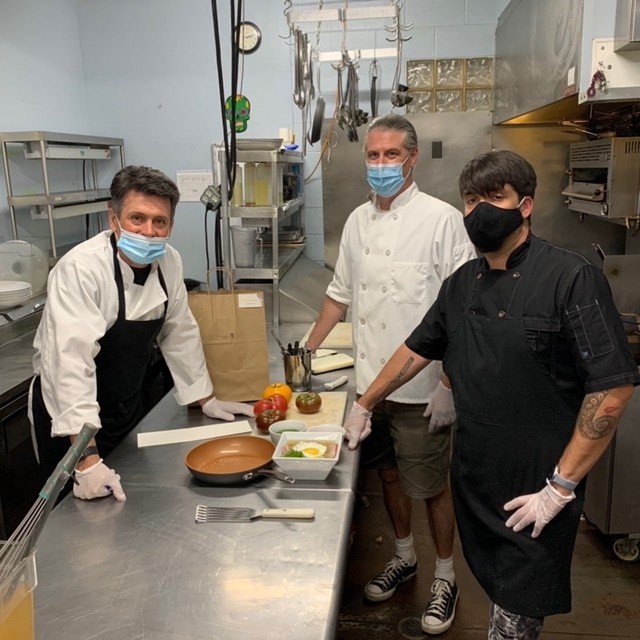No one really knew what to expect when Longmont-area restaurants were given the go-ahead to resume dine-in service on May 27. While owners, chefs and staff were excited to see customers again, they were working to master a checklist of new state guidelines that include mandatory mask wearing, elevated sanitation requirements and lowered seating capacity limits.
A month later, restaurants have a better idea of what it’s like to operate in a world with COVID-19. At least two things are clear: their challenges aren’t over and relationships with customers and the Longmont community are more important than ever.
Tortugas seafood restaurant, located in a small historic house in Old Town, experienced an approximate 80% drop in business starting in late March. Owner Tripp Lindley said it is still at just about 50% of typical levels.
“While the governor has given the go-ahead for table service to resume, customers are deciding the pace at which things will return to normal,” Lindley said.
Currently, the restaurant’s business is split almost down the middle between curbside pickups and dine-in orders. Tortugas’ capacity for table service is still dramatically less than pre-COVID levels and, for the first time in its history, it is taking reservations for patio seating.
Community support for the restaurant has been inspiring and many customers go out of their way to regularly eat at Tortugas, Lindley said. At the same time, the restaurant has seen some challenging customer behavior. Staff has had to turn down diners who won’t wear masks or who haven’t made a reservation and can’t be served upon arrival. That’s tough for the restaurant to do right now.
Like Tortugas, fine dining restaurant Sugarbeet had an 80% drop in sales in late March and has had a core base of customers supporting it. Restaurant partner Ari Kara said, “We lost a lot of business but the (customers) we kept were loyal. At this point, we’re doing everything we can to respect the state’s rules so that we don’t need to close again.”
Chef James Cordova said it has been challenging to preserve Sugarbeet’s menu standards in a to-go environment, which remains part of its business.
“We simplified menus so that food could travel and be made with a minimal amount of kitchen staff,” Cordova said. “We had to consider how well our food items would work for someone who was 15 minutes late for pickup or who had to drive a total of 30 minutes before they’d eat it at home.”
Even with reopening in place, Cordova said he’s sticking with the simplified menu. Staff also is getting creative to keep things fresh. For example, they repurposed the larger, slower melting ice cubes, typically used for high-end Bourbon, as ice packs placed outside of to-go drinks and food. They work because they’re colder, melt slower and don’t risk adding water to food or drinks.
Sean Gafner, owner of three Old Town Longmont restaurants — The Roost, Jefe’s Tacos & Tequila, and Smokin’ Bowls — said for him the reopening process was exhausting.
“In many ways, it felt like as big a project as opening the first time,” he said.
Now that the restaurants are reopened, he said they’re operating at about 70% of sales when compared to the same period last year.
Events also are returning to Gafner’s restaurants. The Roost is planning to host live music under the LosArcos archways on Main Street. Concerts are scheduled Fridays and Saturdays throughout the summer and will be easy to experience at a distance.
As restaurants reopened, what stood out to Gafner was the support from both the Longmont community to restaurants and the businesses to each other. Gafner received 18 free tables and 30 chairs from the owners of Ziggi’s Coffee, who were looking to change their outdoor seating. The furniture was repurposed and has been set up on patios at The Roost and Jefe’s. Gafner estimated the donation saved him about $10,000.
Kimberly McKee, executive director of the Longmont Downtown Development Authority, has seen numerous examples of businesses helping each other adjust to the new guidelines and get through COVID-19 challenges. She echoed restaurateurs' comments that “with the state regulations, it's great for them to be open but many of them are at just half-capacity for seating. Takeout is still important.”
She also reiterated that these restaurants are unique and support for them right now is crucial.
“Keep these local businesses on your mind as you’re deciding where to spend your money. If they close, you can’t just go to another community and get the same food,” she said.
Five ways to support Longmont restaurants
According to restaurant owners, here’s what you can do to show your support:
-
Dine locally — To these businesses, your dollar is important. To servers, every tip counts.
-
Wear your mask — It keeps the environment safe for customers and lowers the chances restaurants will have to again close for dine-in service.
-
Respect social distancing of tables and stay seated — This also makes for a safer customer environment and reduces closure risks.
-
Make a reservation — Calling ahead ensures you can be accommodated, even with reduced seating capacity. It also helps restaurants plan for food and staffing needs.
-
Keep party size in mind — If your party is too large, expect to be seated as if you were two or three separate groups.


